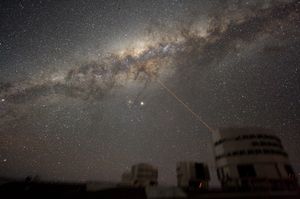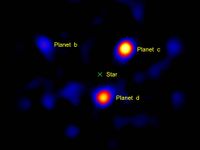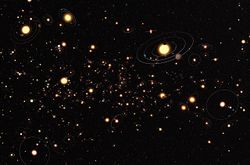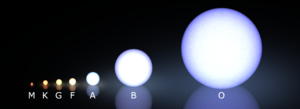كوكب خارجي

الكوكب خارج المجموعة الشمسية Extrasolar planet، هو أي كوكب يوجد خارج نطاق المجموعة الشمسية (الكواكب التي نعرفعا التابعة للشمس كالأرض والمريخ والمشتري وغيرها). نبحث عن تلك الكواكب في محيط نجوم أخرى من الممكن أن تشكل أنظمة كوكبية فثلما في حالة الشمس. منذ عام 1991 حتى 13 مارس 2012 تم اكتشاف 760 كواكب تقع خارج المجموعة الشمسية. وقد تم اكتشاف وجود معظم تلك الكواكب بطرق غير مباشرة وليس بالرؤية المباشرة لأن قربها من نجم ساطع يجعل رؤيتها مباشرة صعب جداً.
. . . . . . . . . . . . . . . . . . . . . . . . . . . . . . . . . . . . . . . . . . . . . . . . . . . . . . . . . . . . . . . . . . . . . . . . . . . . . . . . . . . . . . . . . . . . . . . . . . . . . . . . . . . . . . . . . . . . . . . . . . . . . . . . . . . . . . . . . . . . . . . . . . . . . . . . . . . . . . . . . . . . . . . .
تاريخ الاكتشاف
التكهنات المبكرة
مزاعم فقدت مصداقيتها
اكتشافات مؤكدة



طرق التحقق

التعريف
نظام التسمية
الأنواع
تختلف الكواكب الواقعة خارج المجموعة الشمسية عند مقارنتها بكواكب المجموعة:
- بعضها كواكب غازية أو صخرية ضخمة.
- بعضها يدور حول أكثر من نجم.
- بعضها يسبح في الفلك بطلاقة، وبعضها يدور حول أقزام بنية.
- من الممكن أن يحتوي بعضها على حياة (رغم أن ذلك لم يكتشف بعد).
- يمكن أن يكونوا أقزام كواكب، وهي كواكب أصغر حجماً وكثافة عن الكواكب العادية.
في فبراير 2009 أعلن عن اكتشاف المسبار كوروت لكوكب يدور حول نجم يبعد عن الأرض بمقدار 400 سنة ضوئية. وأطلق على الكوكب اسم كوروت-إكسو-7ب. ومن الأمثلة أيضا على الكواكب المكتشفة خارج النظام الشمسي كوكب ناري تهطل عليه من نار تحتوي على الصخور والحصى، وذلك حسبما ذكرت وكالة الفضاء الأوروبية. ونقلت صحيفة "تلغراف" البريطانية عن علماء فضاء في جامعة واشنطن الأمريكية قولهم إن الكوكب، الذي أطلق عليه اسم "كوروت -7بي" يعتبر "صورة عن الجحيم".
وأضافوا أنه كوكب صخري يبلغ حجمه ضعفي حجم كوكب الأرض، ويبعد مسافة 1.6 مليون ميل عن شمسه، ما يعني أن هذا الكوكب قريب جداً من شمسه ومحبوس بفعل الجاذبية، مثل القمر مع الأرض. وبسبب قربه من شمسه، فإن درجة حرارة الكوكب عالية جداً، مما يتسبب في ذوبان الصخور على سطحة، فتتصاعد الأبخرة قبل أن تتجمد وتتحول إلى صخور وحصى ثم تهطل مجدداً كوابل من المطر في دورة لا تنتهي. وهنالك أيضا كواكب كثيرة تدور حول نظام شمسي آخر.
انظر أيضاً
خصائص عامة
عدد النجوم والكواكب

خصائص النجوم المضيفة
. . . . . . . . . . . . . . . . . . . . . . . . . . . . . . . . . . . . . . . . . . . . . . . . . . . . . . . . . . . . . . . . . . . . . . . . . . . . . . . . . . . . . . . . . . . . . . . . . . . . . . . . . . . . . . . . . . . . . . . . . . . . . . . . . . . . . . . . . . . . . . . . . . . . . . . . . . . . . . . . . . . . . . . .
التصنيف الطيفي
المعدنية
المتغيرات المدارية

المحور شبه الرئيسي
الاختلاف المركزي
درجة الميل
الرنين
المدار
توزيع الكتلة
الكثافة والتكوين

الغلاف الجوي
درجة الحرارة
خصائص أخرى
. . . . . . . . . . . . . . . . . . . . . . . . . . . . . . . . . . . . . . . . . . . . . . . . . . . . . . . . . . . . . . . . . . . . . . . . . . . . . . . . . . . . . . . . . . . . . . . . . . . . . . . . . . . . . . . . . . . . . . . . . . . . . . . . . . . . . . . . . . . . . . . . . . . . . . . . . . . . . . . . . . . . . . . .
إمكانية الحياة
انظر أيضاً
قوائم
- قوائم النجوم المضيفة للكواكب خارج المجموعة الشمسية
- List of extrasolar planets detected by microlensing
- List of extrasolar planets detected by radial velocity
- List of extrasolar planets detected by timing
- List of extrasolar planet extremes
- List of extrasolar planets that were directly imaged
- List of planetary systems
- List of transiting extrasolar planets
- List of unconfirmed exoplanets
تصنيفات
- كوكب كربوني
- Circumbinary planet
- Chthonian planet
- كوكب عديم اللون
- Eccentric Jupiter
- Extragalactic planet
- قمر خارج المجموعة الشمسية
- عملاق غازي
- Goldilocks planet
- كوكب هيليوم
- المشترى الساخن
- نپتون الساخن
- Interstellar planet
- كوكب حديدي
- كوكب محيطي
- نظام الكواكب
- Pulsar planet
- Sudarsky extrasolar planet classification
- Super-Earth
- كوكب أرضي
إمكانية الحياة
- علم الأحياء الفلكي
- Drake equation
- Extraterrestrial life
- Extraterrestrial liquid water
- Fermi paradox
- Hypothetical types of biochemistry
- Planetary habitability
- Rare Earth hypothesis
رواد فضاء
- R. Paul Butler – California radial velocity team
- David Charbonneau − co-discoverer of HD 209458b, the first known transiting exoplanet, and GJ 1214 b, a transiting super-Earth
- Debra Fischer – California radial velocity team
- Dale Frail – co-discoverer of PSR B1257+12 B and C
- John A. Johnson – Researcher with NASA's Exoplanet Science Research Institute at Caltech
- Geoffrey Marcy – California radial velocity team
- Michel Mayor – Swiss radial velocity team, co-discoverer of 51 Pegasi b, the first confirmed exoplanet orbiting a Sun-like star
- Didier Queloz – Swiss radial velocity team, co-discoverer of 51 Pegasi b
- Stephane Udry – Swiss radial velocity team, co-discoverer of Gliese 581 c, the most Earth-like planet
- Aleksander Wolszczan – co-discoverer of PSR B1257+12 B and C, the first confirmed exoplanets
برامج وأجهزة رصد
- Anglo-Australian Planet Search (AAPS)
- Automated Planet Finder at Lick Observatory
- California & Carnegie Planet Search
- CORALIE spectrograph
- East-Asian Planet Search Network (EAPSNet)
- EPICS for the European Extremely Large Telescope
- ESPRESSO is a new-generation spectrograph for ESO's VLT, capable of detecting Earth-like planets.
- FINDS Exo-Earths
- Gemini Planet Imager
- Geneva Extrasolar Planet Search
- HATNet Project (HAT)
- High Accuracy Radial Velocity Planet Searcher (HARPS)
- High Resolution Echelle Spectrometer (HIRES)
- Magellan Planet Search Program
- MEarth Project
- Microlensing Follow-Up Network (MicroFUN)
- Microlensing Observations in Astrophysics (MOA)
- Okayama Planet Search Program
- Optical Gravitational Lensing Experiment (OGLE)
- PlanetPol
- PRL Advanced Radial-velocity All-sky Search (PARAS)
- Sagittarius Window Eclipsing Extrasolar Planet Search
- Search for Extraterrestrial Intelligence (SETI)
- SOPHIE échelle spectrograph
- Subaru telescope, using the High-Contrast Coronographic Imager for Adaptive Optics (HiCIAO)
- SuperWASP (WASP)
- Systemic, an amateur search project
- Trans-Atlantic Exoplanet Survey (TrES)
- XO Telescope (XO)
- ZIMPOL/CHEOPS, based at VLT.
مهمات
حالية
تحت التطوير
- CHEOPS – launch in 2017
- Gaia – launch in August 2013.[5]
- تلسكوپ جيمس وب الفضائي
مقترحة
- ATLAST
- EChO – for launch in 2024
- FINESSE
- New Worlds Mission – for launch in 2019
- PLATO – for launch in 2024
- TESS – NASA studied but declined to select for flight. Private funding is now being sought for launch no earlier than 2016[6]
سابقة
مواقع إلكترونية
المصادر
- ^ Claven, Whitney (3 January 2013). "Billions and Billions of Planets". NASA. Retrieved 3 January 2013.
- ^ "100 Billion Alien Planets Fill Our Milky Way Galaxy: Study". Space.com. 2 January 2013. Retrieved 3 January 2013.
{{cite web}}: Cite uses deprecated parameter|authors=(help) - ^ Cassan, A; Kubas, D.; Beaulieu, J.-P.; Dominik, M.; Horne, K.; Greenhill, J.; Wambsganss, J.; Menzies, J.; Williams, A. (11 January 2012). "One or more bound planets per Milky Way star from microlensing observations". Nature. 481 (7380): 167–169. arXiv:1202.0903. Bibcode:2012Natur.481..167C. doi:10.1038/nature10684. PMID 22237108. Retrieved 2012-01-11.
- ^ "Planet Population is Plentiful". ESO Press Release. Retrieved 13 January 2012.
- ^ "DPAC Newsletter no. 15" (PDF). European Space Agency. January 30, 2012. Retrieved August 31, 2012.
- ^ Ricker, George R.; Latham, D. W.; Vanderspek, R. K.; Ennico, K. A.; Bakos, G.; Brown, T. M.; Burgasser, A. J.; Charbonneau, D.; Clampin, M. (2010). "Transiting Exoplanet Survey Satellite (TESS)". American Astronomical Society. Adsabs.harvard.edu. 215: 459. Bibcode:2010AAS...21545006R.
وصلات خارجية
مشروعات بحثية
- University of California Planet Search Project
- The Geneva Extrasolar Planet Search Programmes
- PlanetQuest distributed computing project
- SuperWASP Wide Angle Search for Planets
مراجع
- The Extrasolar Planets Encyclopaedia (Paris Observatory)
- The Habitable Exoplanets Catalog (PHL/UPR Arecibo)
- The Habitable Zone Gallery
- NASA Exoplanet Archive
- The Visual Exoplanet Catalogue
- Exoplanets: Interactive Visual of XKCD 1071
- Exoplanet database for iPhone/iPod/iPad with visualizations
- 10 Things You May Not Know About... Exoplanets
- NASA's PlanetQuest
- A Zoo of Extra-Solar Planets (audio and transcript) — Astronomy Cast on 9 February 2009 with Pamela Gay and Chris Lintott
- Standard3D Stereoscopic Space Exploration Simulator including 30 exoplanets
- The detection and characterization of exoplanets
- Beyond Our Solar System by NASA's Solar System Exploration
- German Center for Exo-Planet Research Jena/Tautenburg
- Astrophysical Institute & University Observatory Jena (AIU)
- exosolar.net 3D Flash StarMap (2000 Stars and all known Exoplanets)
- Transiting Exoplanet Light Curves Using Differential Photometry
- searchable dynamic database of extrasolar planets and their parent stars
- List of important exoplanets
- Extrasolar Planets – D. Montes, UCM
- Exoplanets at Paris Observatory
- Planetary Society Catalog of Exoplanets
- "Exoplanets in relation to host star's current habitable zone". planetarybiology.com.
- Exoplanets – the search for planets beyond our solar system
- Doyle, Laurence R. (19 March 2009). "Naming New Extrasolar Planets". SETI institute. SPACE.com. Retrieved 2010-06-02.
- ETD – Exoplanet Transit Database (Exoplanet Transit Database)
- Exomol Project Spectroscopic database of molecules of importance for the characterization of exoplanets.
أخبار
- Exoplanet Caught on the Move For the first time, astronomers have been able to directly follow the motion of an exoplanet as it moves from one side of its host star to the other.
- 6–8 Earth-Mass Planet Discovered orbiting Gliese 876
- "On the possible correlation between the orbital periods of extrasolar planets and the metallicity of the host stars". Wiley Interscience. Retrieved 2008-08-20.
- Mark R. Swain, Gautam Vasisht & Giovanna Tinetti (2008). "The presence of methane in the atmosphere of an extrasolar planet". Nature. 452 (7185): 329–331. Bibcode:2008Natur.452..329S. doi:10.1038/nature06823. PMID 18354477.
- Artie P. Hatzes & Günther Wuchter (2005). "Astronomy: Giant planet seeks nursery place". Nature. 436 (7048): 182–183. Bibcode:2005Natur.436..182H. doi:10.1038/436182a. PMID 16015311.
- "Radio Detection of Extrasolar Planets: Present and Future Prospects" (PDF). NRL, NASA/GSFC, NRAO, Observatoìre de Paris. Retrieved 2008-10-15.
- APOD: Likely first direct image of extra-solar planet
- CS1 errors: deprecated parameters
- Articles with hatnote templates targeting a nonexistent page
- Pages with empty portal template
- مقالات مميزة
- البحث عن كائنات ذكية خارج الأرض
- أنواع الكواكب
- كواكب خارج المجموعة الشمسية
- كواكب
- مقالات جيدة في es
- مقالات جيدة في ko
- مقالات مختارة في en
- مقالات مختارة في hu
- مقالات مختارة في th


